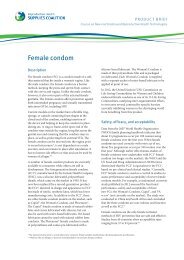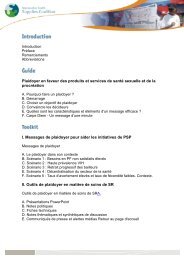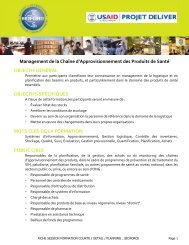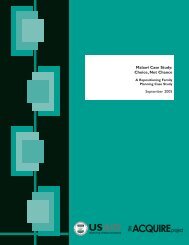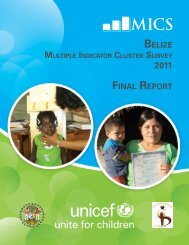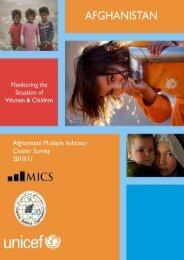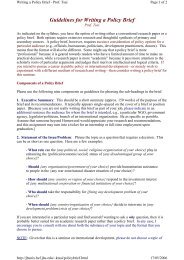Female condom - Reproductive Health Supplies Coalition
Female condom - Reproductive Health Supplies Coalition
Female condom - Reproductive Health Supplies Coalition
You also want an ePaper? Increase the reach of your titles
YUMPU automatically turns print PDFs into web optimized ePapers that Google loves.
PRODUCT BRIEFCaucus on New and Underused <strong>Reproductive</strong> <strong>Health</strong> Technologies<strong>Female</strong> <strong>condom</strong>DescriptionThe female <strong>condom</strong> (FC) is a <strong>condom</strong> made of a soft,thin material that fits inside a woman’s vagina. Likethe male <strong>condom</strong>, the female <strong>condom</strong> is a barriermethod, keeping the penis and sperm from contactwith the cervix and vagina. Unlike the male <strong>condom</strong>,however, it also covers parts of the external femalegenitalia. The female <strong>condom</strong> offers protection againstboth unintended pregnancy and sexually transmittedinfections (STIs), including HIV.Current models on the market have a flexible ring,sponge, or capsule containing foam shapes at theclosed end of the <strong>condom</strong>, enabling insertion ofthe device and helping to keep the <strong>condom</strong> in placeduring sex. A ring or frame at the open end of the<strong>condom</strong> stays outside the vagina, lying flat across thegenital area and ensuring that the <strong>condom</strong> stays inplace, as well as protecting from external STIs. Thefemale <strong>condom</strong> can be inserted into the vagina priorto sexual intercourse*, is not dependent on a maleerection, and can remain in place after ejaculation. Ithas no known side effects or risks and can be used bywomen of all ages.**A number of female <strong>condom</strong> products are currentlyavailable to consumers while others are still indevelopment. The first generation female <strong>condom</strong>(FC1®), manufactured by the <strong>Female</strong> <strong>Health</strong> Company(FHC), was a silicone-lubricated, polyurethanesheath, which came on the market in 1992. It hasnow been replaced by a second-generation product,the FC2®, identical in design and appearance to FC1®but made of nitrile, synthetic latex, which has lowermanufacturing costs. In addition to the FC2®, thereare other female <strong>condom</strong> models on the market, suchas Cupid, the Woman’s Condom, and Phoenurse®.The Cupid female <strong>condom</strong> is made of natural rubberlatex and comes lubricated with silicone, but canalso be used with water-based lubricants. Oil-basedlubricants cannot be used with natural rubber latex<strong>condom</strong>s. The Phoenurse® female <strong>condom</strong> is madeof polyurethane and comes pre-lubricated with asilicone-based lubricant. The Woman’s Condom ismade of thin polyurethane film and is packagedun-lubricated. Each Woman’s Condom is suppliedwith a separate sachet of water-based lubricant to beapplied at point of use.In 2012, the United Nations (UN) Commission onLife-Saving Commodities for Women and Childrenendorsed female <strong>condom</strong>s as one of its 13 Life-SavingCommodities, catalyzing inter-organizational effortsto overcome several commodity-specific barrierscurrently inhibiting women in the developing worldfrom benefiting from this product.Safety, efficacy, and acceptabilityData from the 2007 World <strong>Health</strong> Organization(WHO) family planning handbook indicates thatabout 21 pregnancies occur per 100 women usingfemale <strong>condom</strong>s over the first year. When female<strong>condom</strong>s are used correctly with every act of sex,about five pregnancies occur per 100 women over thefirst year. 1 Although earlier effectiveness studies offemale <strong>condom</strong>s were undertaken with FC1® female<strong>condom</strong> (no longer on the market), the WHO and theUS Food and Drug Administration (USFDA) havedetermined that the FC2® is equivalent to the FC1®,based on pre-clinical and clinical studies. 2 Currently,FC2® female <strong>condom</strong> is used as a control in studies toassess performance and acceptability of newer female<strong>condom</strong> models. For example, a randomized crossoverstudy published in 2012 assessed the functionalperformance, safety, and acceptability of threenew FCs: the Woman’s Condom, Cupid, and VAw.o.w® (not currently on the market). The study wasconducted in China and South Africa and concludedthat the three <strong>condom</strong>s are non-inferior and functionas well as the FC2®. 3<strong>Female</strong> <strong>condom</strong>s are the only female-initiatedmethods of HIV prevention that are safe and effective.Studies from 40 countries show acceptability ratesranging from 37 to 93 percent. 4,5* The amount of time prior to sexual intercourse varies per female <strong>condom</strong> model; please check manufacturer specifications.** Women who are allergic to latex are recommended to not use latex female <strong>condom</strong>s.
CAUCUS ON NEW AND UNDERUSED REPRODUCTIVE HEALTH TECHNOLOGIES PRODUCT BRIEFCurrent program/sector useSince 1993, female <strong>condom</strong>s have been distributedin 130 countries, and public-sector programs areunderway in several of these countries.The FC2® is purchased for public-sector programs byorganizations such as the US Agency for InternationalDevelopment (USAID), the United NationsPopulation Fund (UNFPA), and governmental healthministries. The <strong>Female</strong> <strong>Health</strong> Company reportedsales of 60 million units of FC2® in 2012. 6The Cupid female <strong>condom</strong> has recently been WHOprequalified and approved for bulk procurement byUN agencies. Until now, the Cupid was distributedthrough limited channels in Brazil, India, Indonesia,Kyrgyz Republic, Mozambique, the Netherlands, andSouth Africa. Between 2010 and 2013, Cupid Ltd.reported that over 2.5 million units of the female<strong>condom</strong> were sold.The Woman’s Condom and Phoenurse® are newerproducts with limited distribution in China. TheWoman’s Condom, branded O’lavie for the Chinesemarket, has been available in China in limitedchannels since late 2011. It is expected to becomeavailable in South Africa in 2013.According to the <strong>Reproductive</strong> <strong>Health</strong> Interchange,female <strong>condom</strong>s worth US$28.2 million wereprocured and distributed globally in 2012, by majorprocurement agencies. 7Manufacturers and distributionIncluded below is key information on the manufactureand registration status of the five female <strong>condom</strong>products that are currently on the market.PRODUCT MANUFACTURER REGULATORY STATUS DISTRIBUTION PRICEESTIMATES***FC2® female <strong>condom</strong> (alsoknown under the brand nameFemidon, Protectiv, Care, andmany other names)Made of nitrile (syntheticlatex), pre-lubricatedCupid female <strong>condom</strong>Made of rubber latex,pre-lubricated<strong>Female</strong> <strong>Health</strong>CompanyCupid Ltd., IndiaCE marking;***WHO prequalified 2007, 2012;USFDA approved 2009CE marking;WHO prequalified 2012;USFDA registration processinitiated in 2012Available in 130countriesBrazil, India,Indonesia,Kyrgyz Republic,Mozambique, theNetherlands, andSouth Africa$0.55/unit$0.45/unit at 5million unitsWoman’s Condom (alsoknown as O’lavie for theChina market)Pouch, ring, and foam shapesmade of polyurethane;dissolving insertion capsulemade of polyvinyl alcohol;Shanghai DahuaMedical ApparatusCompany, ChinaCE marking;Under WHO review forprequalification;Undergoing contraceptiveeffectiveness study needed forUSFDA approvalLimited privatesectordistributionin China$0.87/unit at 5million units,volume discountsmay applyNon-lubricated, packaged withwater-based lubricantPhoenurse® female <strong>condom</strong>Made of polyurethane,pre-lubricated withsilicone-based lubricantTianjin CondombaoMedical PolyurethaneTech. Co. Ltd,Tianjin, ChinaCE markingBrazil, China,Kenya, Mexico, andSri Lanka0.59/unit; volumediscounts mayapply*** Pricing information in this table is based on the most accurate information and/or estimates provided by the manufacturer. Prices may fluctuate dependingon various procurement conditions, including volume and contractual stipulation.**** The manufacturer of a product affixes the CE marking to it, assuring the product meets European Economic Area regulations. However, the manufacturersdo have to take certain obligatory steps before the product can bear the CE marking: they must complete a conformity assessment, set up a technical file, and signa European Community declaration of conformity. The document has to be made available to authorities on request.2
CAUCUS ON NEW AND UNDERUSED REPRODUCTIVE HEALTH TECHNOLOGIES PRODUCT BRIEFRegistration statusThe FC2®, Cupid, Phoenurse®, and Woman’s Condomall have a CE marking, which certifies that the producthas met European Union consumer safety, health, andenvironmental requirements.In addition to being WHO prequalified and USFDAapproved, the FC2® is registered in 30 countries and iscurrently pending registration in four countries. Afterreceiving WHO prequalification in 2012, Cupid Ltd.has initiated the female <strong>condom</strong> registration processwith USFDA. Cupid female <strong>condom</strong> is currentlyregistered with the Brazilian Regulatory Agency(ANVISA), Indian Drug Control Authority, and SouthAfrican Bureau of Standards. The Woman’s Condom isregistered in China and registration in South Africa isunderway. Phoenurse® is currently registered in Braziland China.Public-sector price agreementsAt the 2012 Family Planning Summit in London, the<strong>Female</strong> <strong>Health</strong> Company pledged to increase access toFC2® female <strong>condom</strong> for the world’s poorest countriesand announced a prospective pricing arrangementbased on aggregate purchases and 5 percent freegoods based on the prior year’s purchases, togetherwith a multiyear agreement to provide $14 million intraining and education by FHC over the next six years.The Cupid female <strong>condom</strong>s have been sold in KyrgyzRepublic through UNFPA for their public distributionsystem. The Woman’s Condom has been sold to thepublic sector in China. Phoenurse® female <strong>condom</strong>shave not been sold to public-sector purchasers as ofthe date of this publication.Globally, it is acknowledged that further pricereductions are necessary to achieve universal accessto female <strong>condom</strong>s. Based on market analysis it isexpected that sustainable price reductions are feasible.References1. World <strong>Health</strong> Organization (WHO) Department of<strong>Reproductive</strong> <strong>Health</strong> and Research, Johns Hopkins BloombergSchool of Public <strong>Health</strong>/Center for Communication Programs(CCP) INFO Project. Family Planning: A Global Handbook forProviders. Geneva and Baltimore: WHO and CCP; 2007.2. US Food and Drug Administration. Summary of Safety andEffectiveness Data – FC2 <strong>Female</strong> Condom. Available at: http://www.accessdata.fda.gov/scripts/cdrh/cfdocs/cfTopic/pma/pma.cfm?num=P080002. Accessed February 13, 2013.3. Joanis C. A Randomized Controlled Trial of the FunctionalPerformance of New <strong>Female</strong> Condoms: An Evaluation of theWoman’s Condom (WC), FC2, VA w.o.w. and Cupid: FinalReport. Joanis Consulting: Kennesaw, Georgia; 2012.4. Cecil H, et al. The female <strong>condom</strong>: what we have learned thusfar, AIDS and Behavior. 1998;2(3):241–256.5. WHO. The <strong>Female</strong> Condom: A Review. Geneva: WHO; 1997.6. The <strong>Female</strong> <strong>Health</strong> Company website. Available at: www.femalehealth.com.7. <strong>Reproductive</strong> <strong>Health</strong> Interchange website. Available at: http://www.myaccessrh.org/rhi-home. Accessed March 11, 2013.For more information on the Caucus on New and Underused RH Technologies, please visit our web page athttp://www.rhsupplies.org/working-groups/caucus-on-newunderused-rh-technologies.html.This publication forms part of a series of technical briefs, written by members of the Caucus on New and Underused <strong>Reproductive</strong> <strong>Health</strong>Technologies, a thematic group established under the auspices of the <strong>Reproductive</strong> <strong>Health</strong> <strong>Supplies</strong> <strong>Coalition</strong>. The Caucus’ aim is tobroaden the discussion within the <strong>Coalition</strong> of reproductive health technologies that are not well integrated into the public or commercialhealth sectors. Responsibility for the selection and contents of the product briefs rests solely with the Caucus and does not implyendorsement by the <strong>Coalition</strong> or its wider membership. For additional information, please contact secretariat@rhsupplies.org.This brief was last updated May 20133



